The Detection of Motor Bearing Fault with Maximal Overlap Discrete Wavelet Packet Transform and Teager Energy Adaptive Spectral Kurtosis
Abstract
:1. Introduction
- (1)
- By integrating the MODWPT with TEPS, a new bearing detection tool, named the MODWPT-TEASK, for the analysis of vibration signals resulting from bearings with localized defects is presented, which can be used for the diagnosis of single and early weak faults.
- (2)
- The MODWPT-based sub-band analysis is used to analyze the bearing vibration signals and extracts the characteristic features of various bearing faults. The sparse representations of fault features of small incipient bearing defects are obtained by calculating the TEPS of each sub-band signal at different decomposition levels via TEO, thereby enhancing the accuracy of bearing fault detection.
- (3)
- The TEASK dynamically measures the protrusion of the sparse representation to highlight bearing fault characteristic frequency and its harmonics, thereby providing accurate detection results.
- (4)
- The proposed fault detection method based on the MODWPT-TEASK can effectively detect the very weak fault characteristics of bearings under very low SNR. The MODWPT-TEASK also detects bearing fault more accurately than two state-of-the-art methods (FK and Autogram).
2. Proposed Method
2.1. Maximum Overlap Discrete Wavelet Package Transform
2.2. Teager Energy Operator
2.3. Teager Energy Adaptive Spectral Kurtosis
2.4. The Proposed Bearing Fault Detection Scheme
- Preprocess the digitisation of the original vibration signal measured by an accelerometer to obtain the normalized signal with zero mean and unity standard deviation.
- Decompose at level J using Equation (4).
- Calculate the TEO of each node of the MODWPT using Equation (12).
- Apply the DFT to the squared TEO output to obtain the TES using Equation (13).
- Perform the direct approach to compute the TEPS according to the squared magnitude of TES using Equation (14).
- Calculate the TEASK values of all nodes using Equation (18).
- Represent the TEASK values of each node in a two-dimensional color map.
- Select the optimal frequency band based on the overall highest TEASK value.
- Calculate the optimal TEPS using Equation (14).
- Identify bearing characteristic frequency and its harmonics.
3. Simulation Analysis
4. Experimental Apparatus
5. Experimental Results and Discussion
5.1. Bearing Outer-Race Defect Detection
5.2. Bearing Inner-Race Defect Detection
6. Conclusions
Funding
Acknowledgments
Conflicts of Interest
References
- Gangsar, P.; Tiwari, R. Signal based condition monitoring techniques for fault detection and diagnosis of induction motors: A state-of-the-art review. Mech. Syst. Signal Process. 2020, 144, 106908. [Google Scholar] [CrossRef]
- Nandi, A.; Ahmed, H. Principles of Rotating Machine Vibration Signals. In Condition Monitoring with Vibration Signals; John Wiley & Sons, Ltd.: Hoboken, NJ, USA, 2019; Chapter 2; pp. 17–30. [Google Scholar] [CrossRef]
- Randall, R.B.; Antoni, J. Rolling element bearing diagnostics—A tutorial. Mech. Syst. Signal Process. 2011, 25, 485–520. [Google Scholar] [CrossRef]
- Liang, K.; Zhao, M.; Lin, J.; Ding, C.; Jiao, J.; Zhang, Z. A Novel Indicator to Improve Fast Kurtogram for the Health Monitoring of Rolling Bearing. IEEE Sens. J. 2020, 20, 12252–12261. [Google Scholar] [CrossRef]
- Duan, J.; Shi, T.; Zhou, H.; Xuan, J.; Zhang, Y. Multiband Envelope Spectra Extraction for Fault Diagnosis of Rolling Element Bearings. Sensors 2018, 18, 1466. [Google Scholar] [CrossRef] [PubMed] [Green Version]
- Xu, Y.; Zhen, D.; Gu, J.X.; Rabeyee, K.; Chu, F.; Gu, F.; Ball, A.D. Autocorrelated Envelopes for early fault detection of rolling bearings. Mech. Syst. Signal Process. 2021, 146, 106990. [Google Scholar] [CrossRef]
- Antoni, J. The spectral kurtosis: A useful tool for characterising non-stationary signals. Mech. Syst. Signal Process. 2006, 20, 282–307. [Google Scholar] [CrossRef]
- Antoni, J.; Randall, R. The spectral kurtosis: Application to the vibratory surveillance and diagnostics of rotating machines. Mech. Syst. Signal Process. 2006, 20, 308–331. [Google Scholar] [CrossRef]
- Antoni, J. Fast computation of the kurtogram for the detection of transient faults. Mech. Syst. Signal Process. 2007, 21, 108–124. [Google Scholar] [CrossRef]
- Wang, Y.; Xiang, J.; Markert, R.; Liang, M. Spectral kurtosis for fault detection, diagnosis and prognostics of rotating machines: A review with applications. Mech. Syst. Signal Process. 2016, 66-67, 679–698. [Google Scholar] [CrossRef]
- Barszcz, T.; JabŁoński, A. A novel method for the optimal band selection for vibration signal demodulation and comparison with the Kurtogram. Mech. Syst. Signal Process. 2011, 25, 431–451. [Google Scholar] [CrossRef]
- Antoni, J. The infogram: Entropic evidence of the signature of repetitive transients. Mech. Syst. Signal Process. 2016, 74, 73–94. [Google Scholar] [CrossRef]
- Wang, D.; Tse, P.W.; Tsui, K.L. An enhanced Kurtogram method for fault diagnosis of rolling element bearings. Mech. Syst. Signal Process. 2013, 35, 176–199. [Google Scholar] [CrossRef]
- Smith, W.A.; Fan, Z.; Peng, Z.; Li, H.; Randall, R.B. Optimised Spectral Kurtosis for bearing diagnostics under electromagnetic interference. Mech. Syst. Signal Process. 2016, 75, 371–394. [Google Scholar] [CrossRef] [Green Version]
- Moshrefzadeh, A.; Fasana, A. The Autogram: An effective approach for selecting the optimal demodulation band in rolling element bearings diagnosis. Mech. Syst. Signal Process. 2018, 105, 294–318. [Google Scholar] [CrossRef]
- Xu, L.; Chatterton, S.; Pennacchi, P. A Novel Method of Frequency Band Selection for Squared Envelope Analysis for Fault Diagnosing of Rolling Element Bearings in a Locomotive Powertrain. Sensors 2018, 18, 4344. [Google Scholar] [CrossRef] [Green Version]
- Xu, L.; Chatterton, S.; Pennacchi, P. Rolling element bearing diagnosis based on singular value decomposition and composite squared envelope spectrum. Mech. Syst. Signal Process. 2021, 148, 107174. [Google Scholar] [CrossRef]
- Wang, L.; Liu, Z.; Cao, H.; Zhang, X. Subband averaging kurtogram with dual-tree complex wavelet packet transform for rotating machinery fault diagnosis. Mech. Syst. Signal Process. 2020, 142, 106755. [Google Scholar] [CrossRef]
- Borghesani, P.; Pennacchi, P.; Chatterton, S. The relationship between kurtosis- and envelope-based indexes for the diagnostic of rolling element bearings. Mech. Syst. Signal Process. 2014, 43, 25–43. [Google Scholar] [CrossRef]
- Charlton-Perez, C.; Perez, R.; Protopopescu, V.; Worley, B. Detection of unusual events and trends in complex non-stationary data streams. Ann. Nucl. Energy 2011, 38, 489–510. [Google Scholar] [CrossRef]
- Qin, Y. Multicomponent AM–FM demodulation based on energy separation and adaptive filtering. Mech. Syst. Signal Process. 2013, 38, 440–459. [Google Scholar] [CrossRef]
- Yang, D.-M. The detection of bearing incipient fault with maximal overlap discrete wavelet packet transform and sparse code shrinkage denoising. In Proceedings of the 2020 International Symposium on Computer, Consumer and Control (IS3C), Taichung, Taiwan, 13–16 November 2020; pp. 216–219. [Google Scholar] [CrossRef]
- Gu, R.; Chen, J.; Hong, R.; Wang, H.; Wu, W. Incipient fault diagnosis of rolling bearings based on adaptive variational mode decomposition and Teager energy operator. Measurement 2020, 149, 106941. [Google Scholar] [CrossRef]
- Henríquez Rodríguez, P.; Alonso, J.B.; Ferrer, M.A.; Travieso, C.M. Application of the Teager–Kaiser energy operator in bearing fault diagnosis. ISA Trans. 2013, 52, 278–284. [Google Scholar] [CrossRef]
- Liang, M.; Soltani Bozchalooi, I. An energy operator approach to joint application of amplitude and frequency-demodulations for bearing fault detection. Mech. Syst. Signal Process. 2010, 24, 1473–1494. [Google Scholar] [CrossRef]
- Walden, A.T.; Cristan, A.C. The phase-corrected undecimated discrete wavelet packet transform and its application to interpreting the timing of events. Proc. R. Soc. Lond. Ser. A Math. Phys. Eng. Sci. 1998, 454, 2243–2266. [Google Scholar] [CrossRef]
- Percival, D.B.; Walden, A.T. Wavelet Methods for Time Series Analysis; Cambridge University Press: Cambridge, UK, 2006; Volume 4. [Google Scholar] [CrossRef]
- Maragos, P.; Kaiser, J.F.; Quatieri, T.F. On amplitude and frequency demodulation using energy operators. IEEE Trans. Signal Process. 1993, 41, 1532–1550. [Google Scholar] [CrossRef]
- Potamianos, A.; Maragos, P. A comparison of the energy operator and the Hilbert transform approach to signal and speech demodulation. Signal Process. 1994, 37, 95–120. [Google Scholar] [CrossRef]
- Maragos, P.; Kaiser, J.F.; Quatieri, T.F. Energy separation in signal modulations with application to speech analysis. IEEE Trans. Signal Process. 1993, 41, 3024–3051. [Google Scholar] [CrossRef]
- Pang, B.; Tang, G.; Tian, T. Rolling Bearing Fault Diagnosis Based on SVDP-Based Kurtogram and Iterative Autocorrelation of Teager Energy Operator. IEEE Access 2019, 7, 77222–77237. [Google Scholar] [CrossRef]
- Ma, J.; Wu, J.; Wang, X. Incipient fault feature extraction of rolling bearings based on the MVMD and Teager energy operator. ISA Trans. 2018, 80, 297–311. [Google Scholar] [CrossRef]
- Nguyen, H.N.; Kim, J.; Kim, J.M. Optimal Sub-Band Analysis Based on the Envelope Power Spectrum for Effective Fault Detection in Bearing under Variable, Low Speeds. Sensors 2018, 18, 1389. [Google Scholar] [CrossRef] [Green Version]
- Shin, K.; Hammond, J.K. Fundamentals of Signal Processing for Sound and Vibration Engineers; John Wiley & Sons: West Sussex, UK, 2008. [Google Scholar]
- Zhang, X.; Wan, S.; He, Y.; Wang, X.; Dou, L. Teager energy spectral kurtosis of wavelet packet transform and its application in locating the sound source of fault bearing of belt conveyor. Measurement 2021, 173, 108367. [Google Scholar] [CrossRef]
- Wang, Y.; Liang, M. An adaptive SK technique and its application for fault detection of rolling element bearings. Mech. Syst. Signal Process. 2011, 25, 1750–1764. [Google Scholar] [CrossRef]
- Wang, Y.; Xu, G.; Liang, L.; Jiang, K. Detection of weak transient signals based on wavelet packet transform and manifold learning for rolling element bearing fault diagnosis. Mech. Syst. Signal Process. 2015, 54–55, 259–276. [Google Scholar] [CrossRef]
- Nikolaou, N.; Antoniadis, I. Rolling element bearing fault diagnosis using wavelet packets. NDT&E Int. 2002, 35, 197–205. [Google Scholar] [CrossRef]
- Marple, S.L. Digital Spectral Analysis, 2nd ed.; Dover Publications: New York, NY, USA, 2019. [Google Scholar]
- Swanson, D.C. Signal Processing for Intelligent Sensor Systems with MATLAB, 2nd ed.; CRC Press: New York, NY, USA, 2012. [Google Scholar]
- Jauregui Correa, J.C.A.; Lozano Guzman, A.A. Chapter Four—Causes and effects of vibration. In Mechanical Vibrations and Condition Monitoring; Jauregui Correa, J.C.A., Lozano Guzman, A.A., Eds.; Academic Press: Cambridge, MA, USA, 2020; pp. 75–96. [Google Scholar] [CrossRef]
- McFadden, P.; Smith, J. Model for the vibration produced by a single point defect in a rolling element bearing. J. Sound Vib. 1984, 96, 69–82. [Google Scholar] [CrossRef]
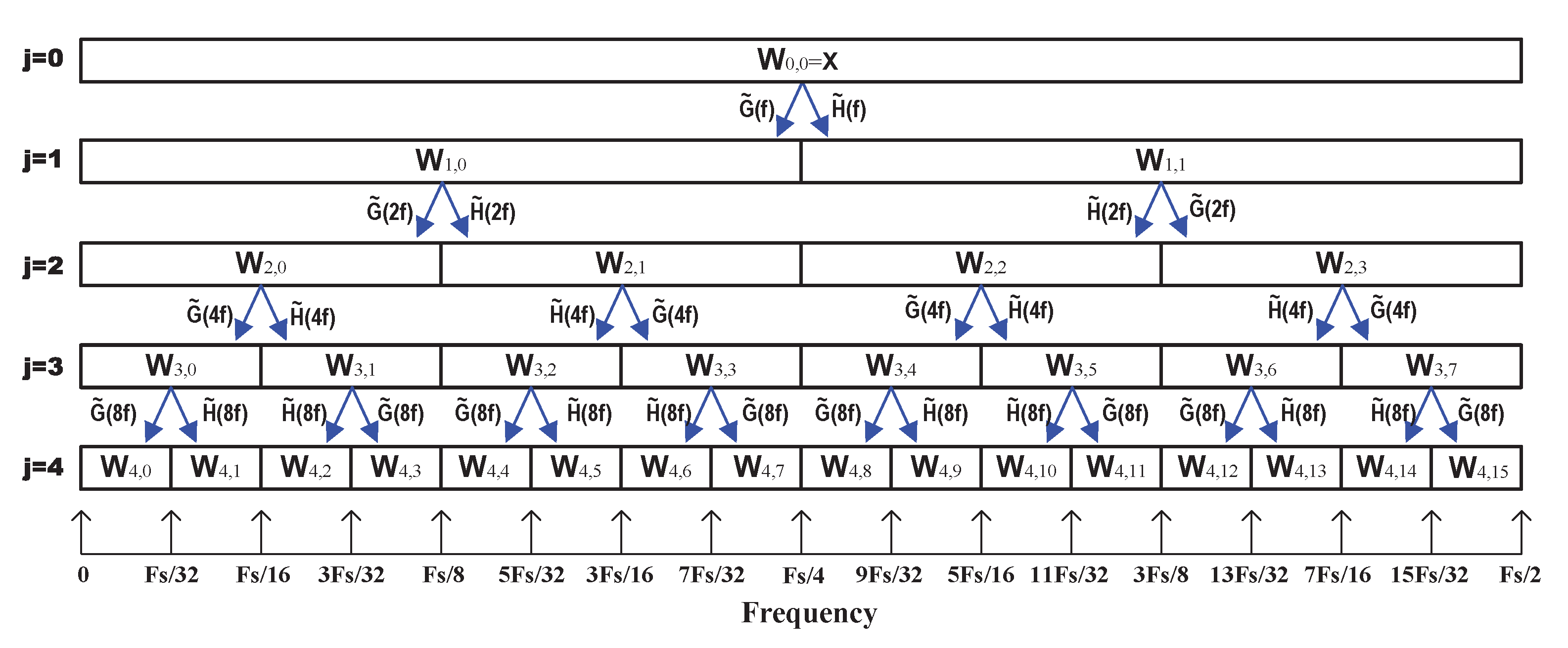
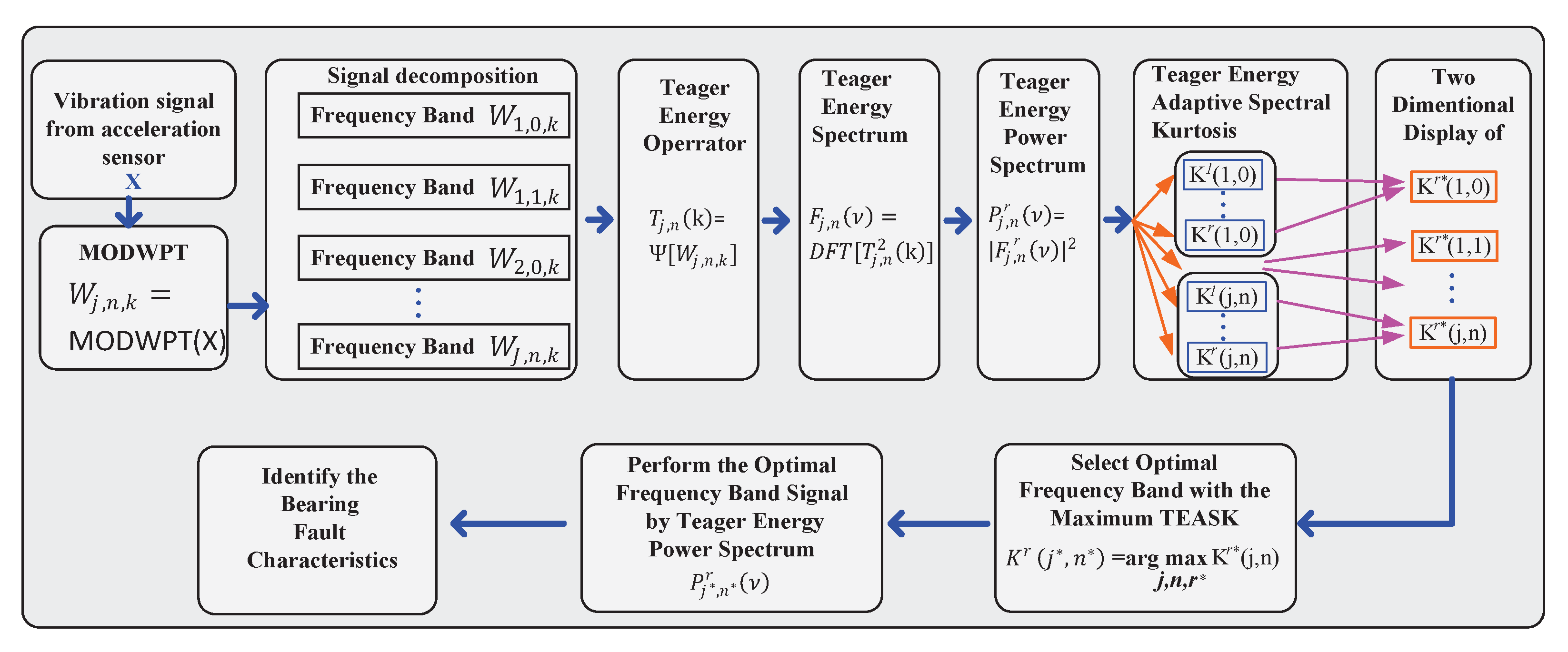
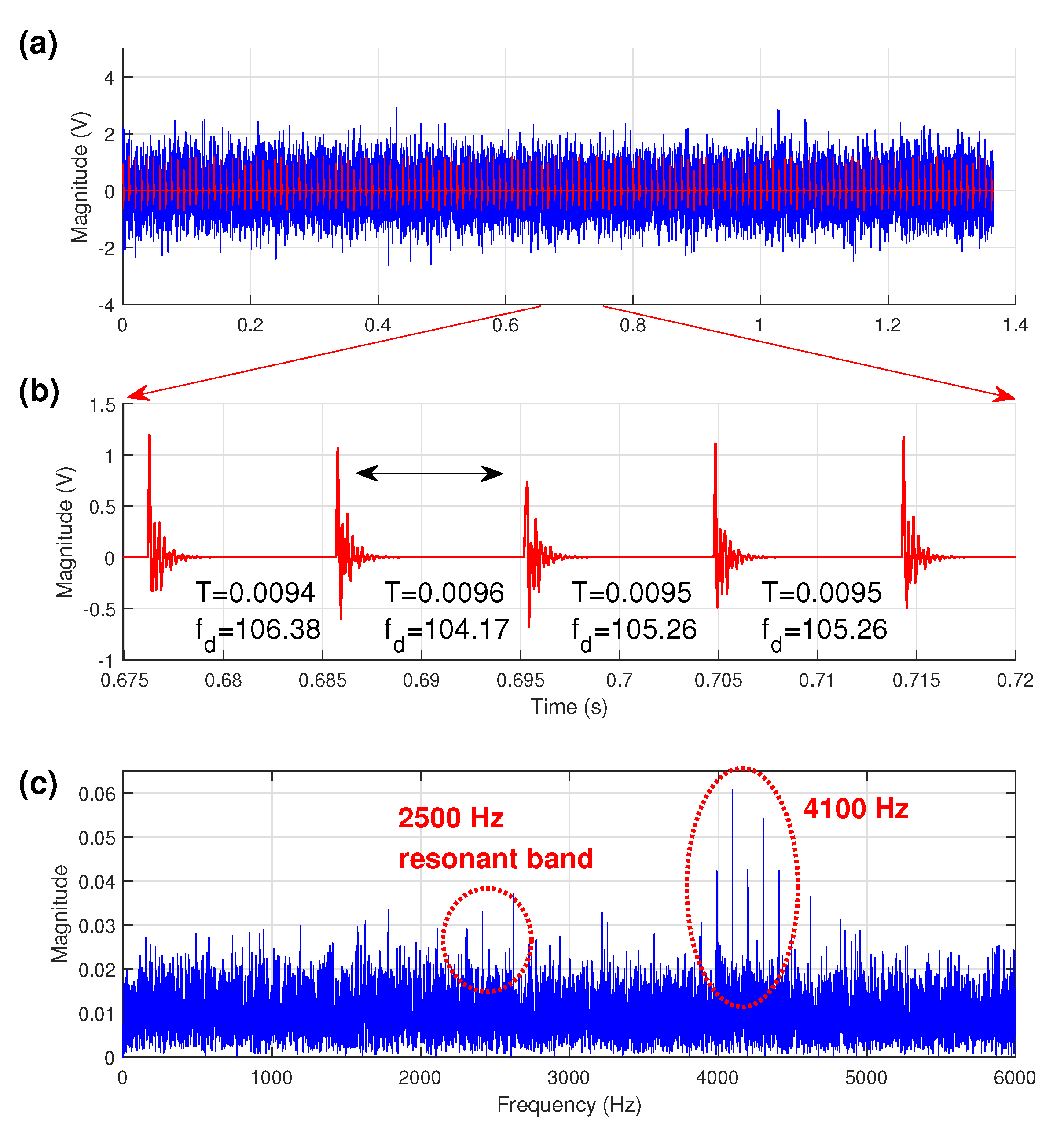
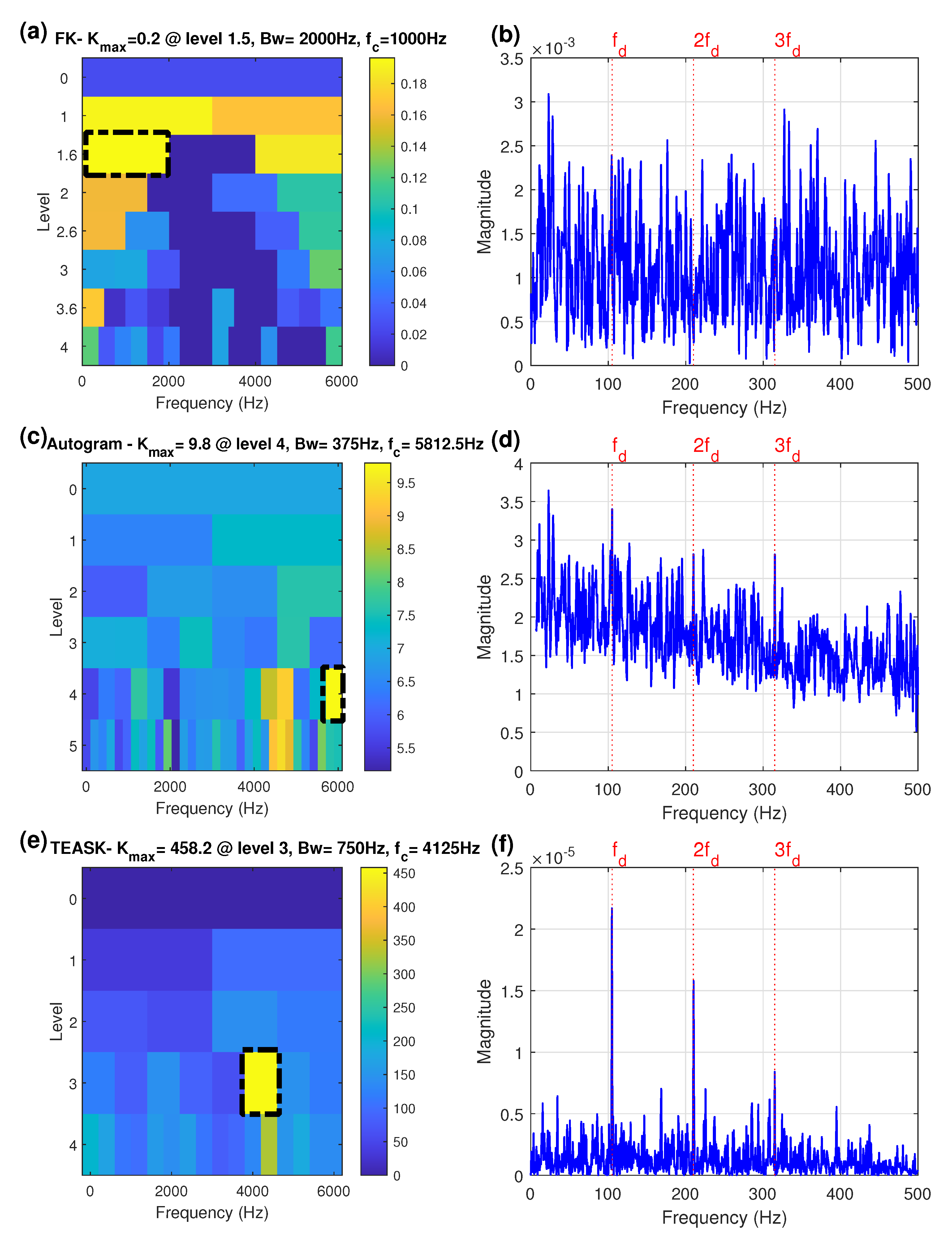


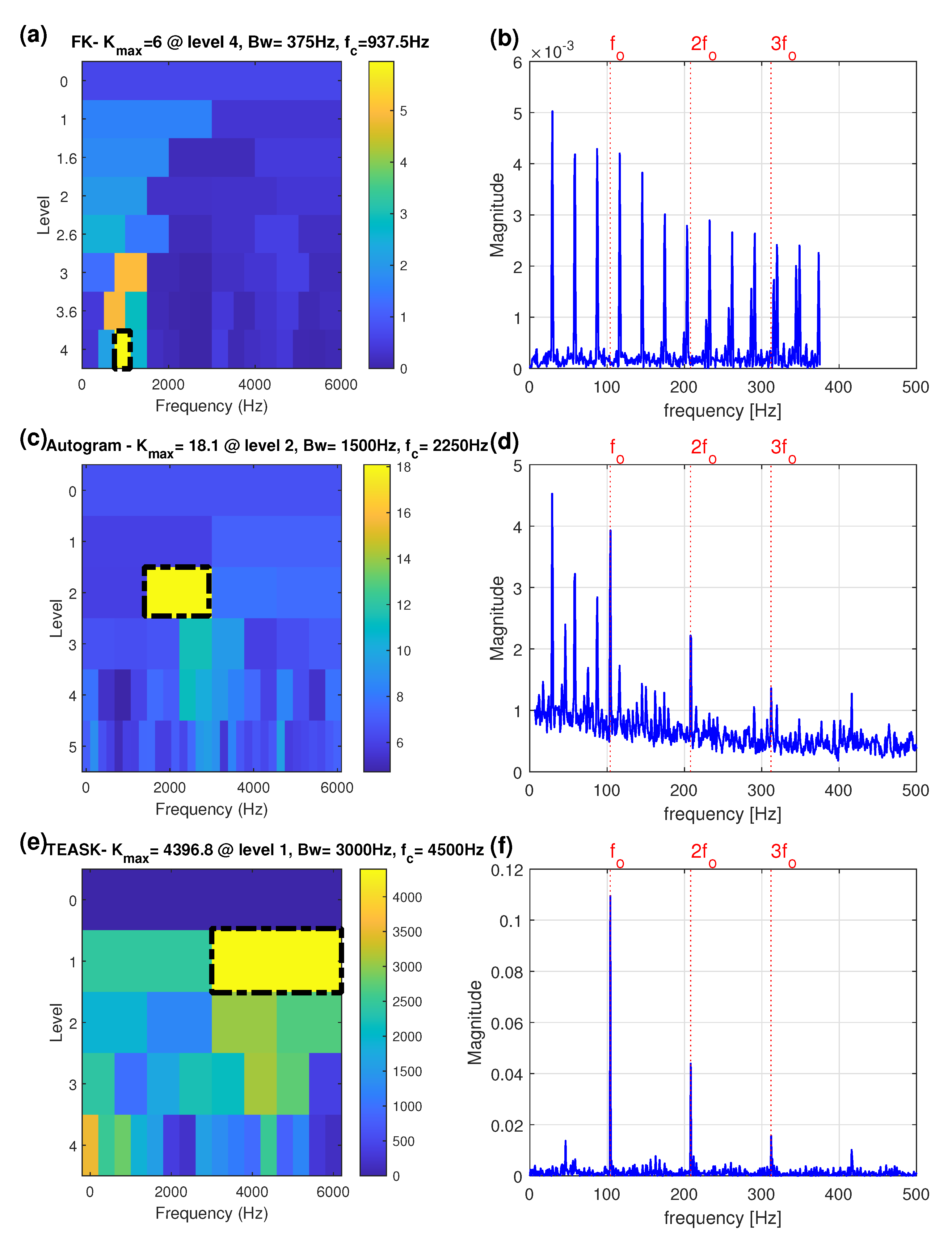

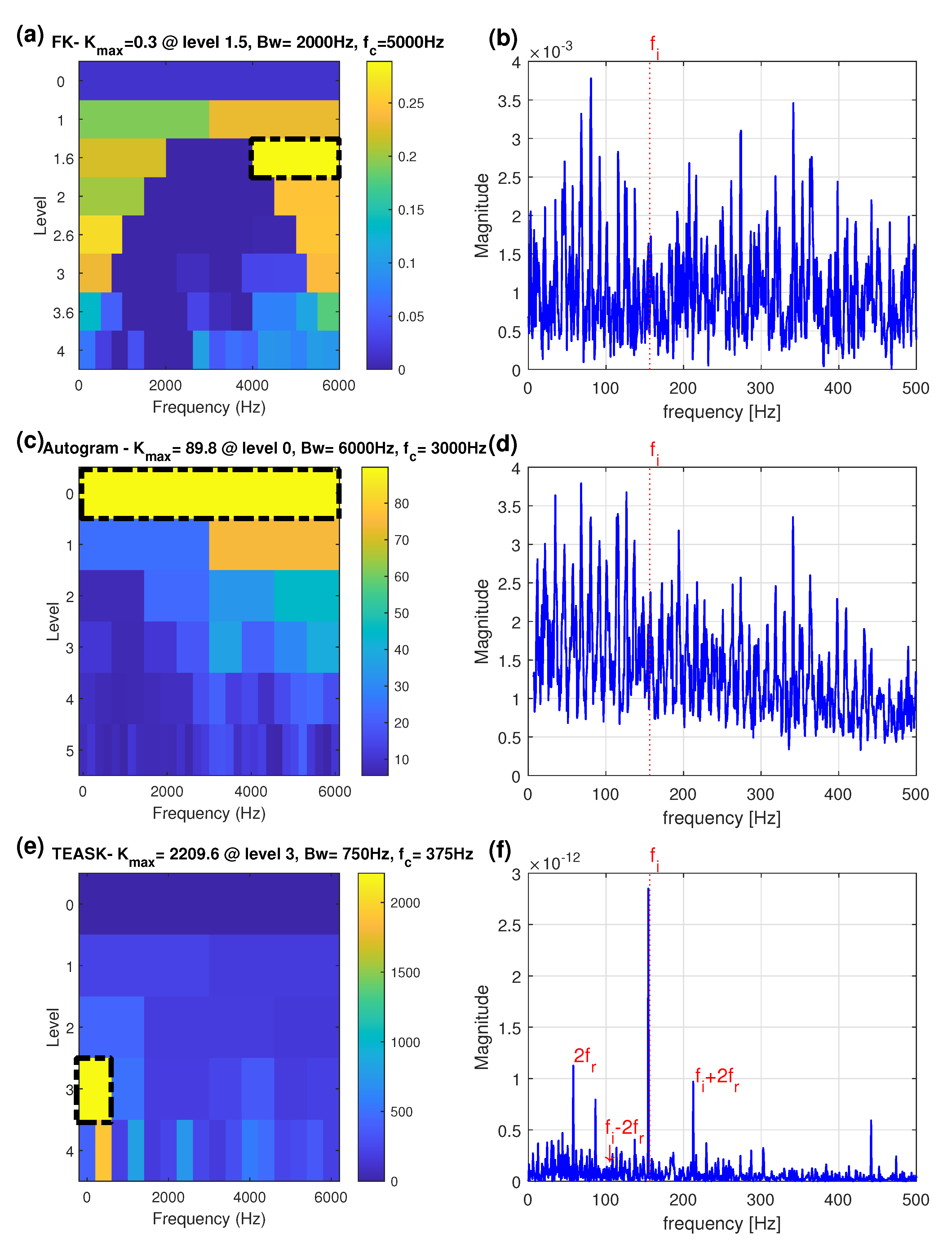
| Parameters | (Hz) | (Hz) | (Hz) | ||||
|---|---|---|---|---|---|---|---|
| Values | 1000 | 105 | 0.4 | 2500 | 1 | 4100 | 1.5% |
| Type | Bore | Outer | Width | Number | Ball | Pitch | ||
|---|---|---|---|---|---|---|---|---|
| Diameter | Diameter | of Balls | Diameter | Diameter | ||||
| (mm) | (mm) | (mm) | (mm) | (mm) | (Hz) | (Hz) | ||
| 6206 | 30 | 62 | 16 | 9 | 9.5 | 46.46 | 3.58 | 5.42 |
Publisher’s Note: MDPI stays neutral with regard to jurisdictional claims in published maps and institutional affiliations. |
© 2021 by the author. Licensee MDPI, Basel, Switzerland. This article is an open access article distributed under the terms and conditions of the Creative Commons Attribution (CC BY) license (https://creativecommons.org/licenses/by/4.0/).
Share and Cite
Yang, D.-M. The Detection of Motor Bearing Fault with Maximal Overlap Discrete Wavelet Packet Transform and Teager Energy Adaptive Spectral Kurtosis. Sensors 2021, 21, 6895. https://doi.org/10.3390/s21206895
Yang D-M. The Detection of Motor Bearing Fault with Maximal Overlap Discrete Wavelet Packet Transform and Teager Energy Adaptive Spectral Kurtosis. Sensors. 2021; 21(20):6895. https://doi.org/10.3390/s21206895
Chicago/Turabian StyleYang, D.-M. 2021. "The Detection of Motor Bearing Fault with Maximal Overlap Discrete Wavelet Packet Transform and Teager Energy Adaptive Spectral Kurtosis" Sensors 21, no. 20: 6895. https://doi.org/10.3390/s21206895
APA StyleYang, D.-M. (2021). The Detection of Motor Bearing Fault with Maximal Overlap Discrete Wavelet Packet Transform and Teager Energy Adaptive Spectral Kurtosis. Sensors, 21(20), 6895. https://doi.org/10.3390/s21206895





